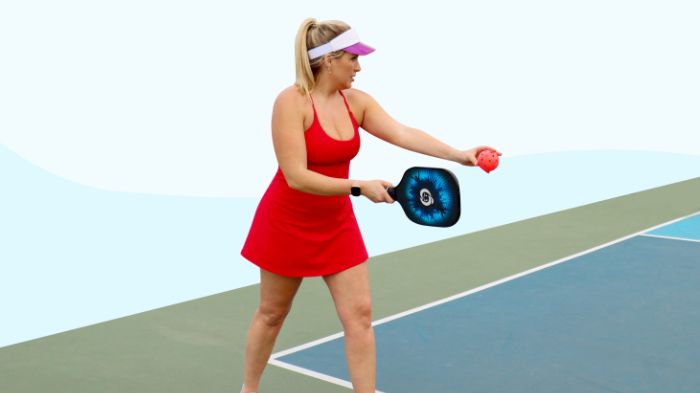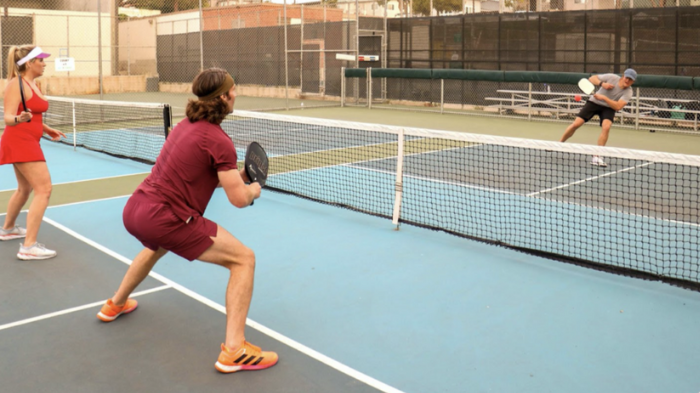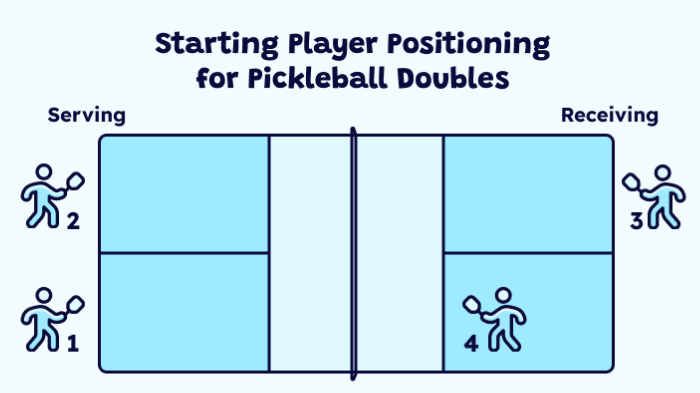Are you new to the world of pickleball and wondering where to stand while serving or returning? Or are you a seasoned player looking to improve your game by perfecting your positioning on the court? Either way, this article is for you!
In this guide, we’ll explore everything there is to know about where to stand in pickleball. From serving rules and positions, returning tactics doubles strategies, and more – we’ve got you covered! So grab your paddle and let’s dive into the exciting world of pickleball positioning.
Where To Stand In Pickleball- Serving and Returning

The key to winning in pickleball is mastering where to Stand in Pickleball while Serving and Returning. And a big part of that is knowing where to stand on the court. Let’s dive deep and find out where to stand in pickleball in different situations.
Where To Stand In Pickleball While Serving
- Serving in pickleball is a crucial part of the game. Your position on the court while serving can impact your accuracy and power, ultimately determining whether or not you win the point. So, where should you stand when serving?
- Firstly, it’s important to remember that you must serve from behind the baseline in pickleball. This means standing at least one foot behind it.
- Many players prefer to stand slightly off-center when serving, as this allows for a better angle to hit both corners of the service box. However, some players may also choose to stand more centered if they have a particularly strong serve down the middle.
- Sometimes the weight of the paddle also affects your posture. Therefore, you should decide that what is the best weight for a pickleball paddle for yourself.
- It’s also worth noting that your stance while serving can affect your consistency and power. A wider stance provides more stability but may limit your range of motion, whereas a narrower stance allows for greater mobility but less stability.
- Ultimately, finding the right spot to stand when serving comes down to personal preference and experimentation with different positions on the court. Just remember to always stay behind that baseline!
Where To Stand In Pickleball While Returning
- After serving in pickleball, it’s time to return the ball. Knowing where to stand while returning can make a big difference in your game. The position you take will depend on several factors such as the speed and spin of the incoming ball, your personal playing style, and your opponent’s position on the court.
- One common strategy is to stand close to the baseline when returning serve. This allows for more time to react and also gives you space to hit powerful returns. However, if your opponent has a strong serve or likes hitting drop shots, standing closer to the net may be necessary.

- Another important factor is how comfortable you are with different types of shots. If you’re confident with both backhand and forehand strokes, try positioning yourself slightly towards one side of the court so that you can cover more ground.
- It’s also crucial to pay attention to your opponent’s movement on their side of the court. If they tend to move towards one side after serving, consider moving in that direction during return play.
Finding the perfect spot on the court for returning requires practice and adaptability based on various situational factors during a game.
Pickleball Rules For Serving and Returning
In pickleball, serving and returning are some of the most essential skills to master. Serving is how a player begins a point while returning is how they respond to their opponent’s serve. To ensure fair play, there are specific rules for serving and returning in pickleball.
- When serving in pickleball, players must stand behind the baseline and within the confines of the service court. The ball must be struck below waist level with an underhand motion. It should also clear the non-volley zone and land within the opposing team’s service court.
- When it comes to returning a serve, players have to let it bounce once before hitting it back over the net. Additionally, they cannot return it volley-style or hit it out-of-bounds or into the net.
- Pickleball doubles have slightly different rules for serving too. In doubles play, each team member takes turns serving until their side commits a fault or loses possession of serve.
- Knowing these pickleball rules can help you improve your game while ensuring fair play on both sides of the court!
Where To Stand in Pickleball Doubles
Knowing where to stand on the pickleball court in doubles is crucial to increase your chances of winning. When serving, the server always stands at the back right corner of the court and serves diagonally to the opponent’s service box.
Once the serve is made, players are free to move within their respective halves of the court, but it’s best to stay near your designated areas to cover more ground when returning shots.

For players who are not serving, standing at the non-volley zone line or “the kitchen” is recommended. The non-serving player should position themselves near the net to be ready for the return shot.
When returning a shot, players should move closer or further away from the net depending on their opponent’s shot placement. This will help players hit the ball without having to take too many steps or reach too far.
By understanding the ideal positioning for players in pickleball doubles and practicing regularly with your partner, you can improve your game and win more matches. Following these guidelines will help you dominate on the court.
To answer you questions like “Can you spike the ball in pickleball“
FAQs
One common mistake is standing too far back from the baseline while serving or returning, which can cause difficulty in reaching shots at net. Another mistake is moving forward towards the net too quickly after hitting a deep return shot which leaves them exposed to drop shots or lobs.
For serving, the player in the right-hand court usually serves, standing at the back right corner of the court. The other player usually stands at the non-volley zone line. For return, players can stand in any position that allows them to return the shot effectively.
Communication is key to successful doubles play. You and your partner should discuss your preferred positions and movements during gameplay. If one of you needs to change positions, communicate with each other to avoid confusion and ensure that both halves of the court are covered.
Yes, you should also consider your opponent’s playing style and tendencies. If they frequently hit cross-court shots, for example, you might want to adjust your position to better cover that area of the court. Additionally, your own strengths and weaknesses as a player should also be taken into account when determining your position on the court.
If you and your partner are struggling to coordinate your positions on the court, it may be helpful to practice together and focus on communication. Additionally, watching videos of successful doubles pairs can help you see how they move and communicate during gameplay. Finally, don’t be afraid to experiment with different positions and strategies to find what works best for you as a team.
Final Thoughts
To wrap up, understanding where to stand in pickleball is crucial for any player’s success. Whether serving or returning, the right position can make all the difference in achieving a successful shot and winning points.
Remember to follow the official rules and regulations of pickleball while serving and returning. In doubles play, communication with your partner is key when deciding where to stand on the court.
By practicing these positions regularly, you will develop muscle memory that will help you react quickly during gameplay. So go ahead and hit the court armed with this knowledge, ready to take on your opponents like a pro.
Find out more about pickleball stacking hand signals



